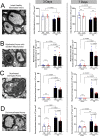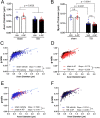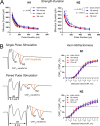Acute axon damage and demyelination are mitigated by 4-aminopyridine (4-AP) therapy after experimental traumatic brain injury
- PMID: 35501931
- PMCID: PMC9059462
- DOI: 10.1186/s40478-022-01366-z
Acute axon damage and demyelination are mitigated by 4-aminopyridine (4-AP) therapy after experimental traumatic brain injury
Abstract
Damage to long axons in white matter tracts is a major pathology in closed head traumatic brain injury (TBI). Acute TBI treatments are needed that protect against axon damage and promote recovery of axon function to prevent long term symptoms and neurodegeneration. Our prior characterization of axon damage and demyelination after TBI led us to examine repurposing of 4-aminopyridine (4-AP), an FDA-approved inhibitor of voltage-gated potassium (Kv) channels. 4-AP is currently indicated to provide symptomatic relief for patients with chronic stage multiple sclerosis, which involves axon damage and demyelination. We tested clinically relevant dosage of 4-AP as an acute treatment for experimental TBI and found multiple benefits in corpus callosum axons. This randomized, controlled pre-clinical study focused on the first week after TBI, when axons are particularly vulnerable. 4-AP treatment initiated one day post-injury dramatically reduced axon damage detected by intra-axonal fluorescence accumulations in Thy1-YFP mice of both sexes. Detailed electron microscopy in C57BL/6 mice showed that 4-AP reduced pathological features of mitochondrial swelling, cytoskeletal disruption, and demyelination at 7 days post-injury. Furthermore, 4-AP improved the molecular organization of axon nodal regions by restoring disrupted paranode domains and reducing Kv1.2 channel dispersion. 4-AP treatment did not resolve deficits in action potential conduction across the corpus callosum, based on ex vivo electrophysiological recordings at 7 days post-TBI. Thus, this first study of 4-AP effects on axon damage in the acute period demonstrates a significant decrease in multiple pathological hallmarks of axon damage after experimental TBI.
Keywords: 4-aminopyridine; Demyelination; Electrophysiology; Kv1.2; Traumatic brain injury; White matter.
© 2022. The Author(s).
Conflict of interest statement
The authors declare no competing financial interests.
Figures







Similar articles
-
Sarm1 deletion reduces axon damage, demyelination, and white matter atrophy after experimental traumatic brain injury.Exp Neurol. 2019 Nov;321:113040. doi: 10.1016/j.expneurol.2019.113040. Epub 2019 Aug 21. Exp Neurol. 2019. PMID: 31445042
-
Experimental Traumatic Brain Injury Identifies Distinct Early and Late Phase Axonal Conduction Deficits of White Matter Pathophysiology, and Reveals Intervening Recovery.J Neurosci. 2018 Oct 10;38(41):8723-8736. doi: 10.1523/JNEUROSCI.0819-18.2018. Epub 2018 Aug 24. J Neurosci. 2018. PMID: 30143572 Free PMC article.
-
Genetic inactivation of SARM1 axon degeneration pathway improves outcome trajectory after experimental traumatic brain injury based on pathological, radiological, and functional measures.Acta Neuropathol Commun. 2021 May 17;9(1):89. doi: 10.1186/s40478-021-01193-8. Acta Neuropathol Commun. 2021. PMID: 34001261 Free PMC article.
-
White matter involvement after TBI: Clues to axon and myelin repair capacity.Exp Neurol. 2016 Jan;275 Pt 3:328-333. doi: 10.1016/j.expneurol.2015.02.011. Epub 2015 Feb 16. Exp Neurol. 2016. PMID: 25697845 Review.
-
Myelin and oligodendrocyte lineage cells in white matter pathology and plasticity after traumatic brain injury.Neuropharmacology. 2016 Nov;110(Pt B):654-659. doi: 10.1016/j.neuropharm.2015.04.029. Epub 2015 May 9. Neuropharmacology. 2016. PMID: 25963414 Review.
Cited by
-
Chemical and biophysical characterization of novel potassium channel blocker 3-fluoro-5-methylpyridin-4-amine.Sci Rep. 2024 May 15;14(1):11105. doi: 10.1038/s41598-024-61465-w. Sci Rep. 2024. PMID: 38750155 Free PMC article.
-
Neuronal tau pathology worsens late-phase white matter degeneration after traumatic brain injury in transgenic mice.Acta Neuropathol. 2023 Oct;146(4):585-610. doi: 10.1007/s00401-023-02622-9. Epub 2023 Aug 14. Acta Neuropathol. 2023. PMID: 37578550 Free PMC article.
-
Thy1-YFP: an effective tool for single cell tracing from neuronal progenitors to mature functionally active neurons.Cell Death Discov. 2025 Jan 22;11(1):18. doi: 10.1038/s41420-025-02297-z. Cell Death Discov. 2025. PMID: 39843432 Free PMC article.
-
Old Age Exacerbates White Matter Neuroinflammation and Cognitive Deficits Following Closed-Head Injury, Particularly in Female Mice.Neurotrauma Rep. 2024 Aug 22;5(1):770-786. doi: 10.1089/neur.2024.0074. eCollection 2024. Neurotrauma Rep. 2024. PMID: 39184175 Free PMC article.
-
Actomyosin-II protects axons from degeneration induced by mild mechanical stress.J Cell Biol. 2024 Aug 5;223(8):e202206046. doi: 10.1083/jcb.202206046. Epub 2024 May 7. J Cell Biol. 2024. PMID: 38713825 Free PMC article.
References
-
- Andravizou A, Dardiotis E, Artemiadis A, Sokratous M, Siokas V, Tsouris Z, Aloizou AM, Nikolaidis I, Bakirtzis C, Tsivgoulis G, et al. Brain atrophy in multiple sclerosis: mechanisms, clinical relevance and treatment options. Auto Immun Highlights. 2019;10:7. doi: 10.1186/s13317-019-0117-5. - DOI - PMC - PubMed
-
- Balan IS, Saladino AJ, Aarabi B, Castellani RJ, Wade C, Stein DM, Eisenberg HM, Chen HH, Fiskum G. Cellular alterations in human traumatic brain injury: changes in mitochondrial morphology reflect regional levels of injury severity. J Neurotrauma. 2013;30:367–381. doi: 10.1089/neu.2012.2339. - DOI - PMC - PubMed
Publication types
MeSH terms
Substances
LinkOut - more resources
Full Text Sources
Other Literature Sources
Medical
Miscellaneous

